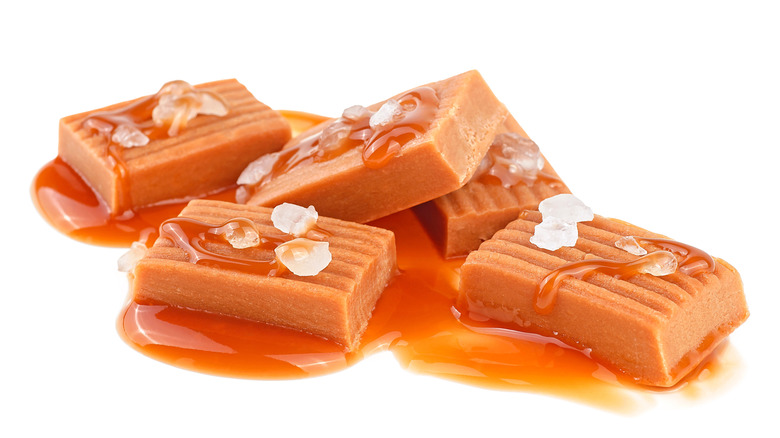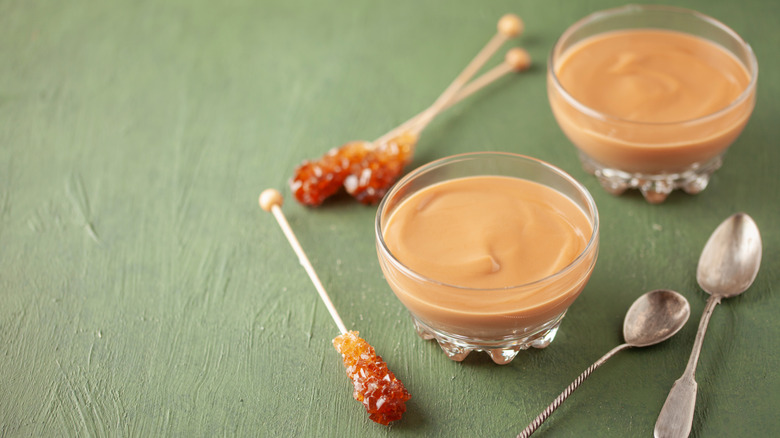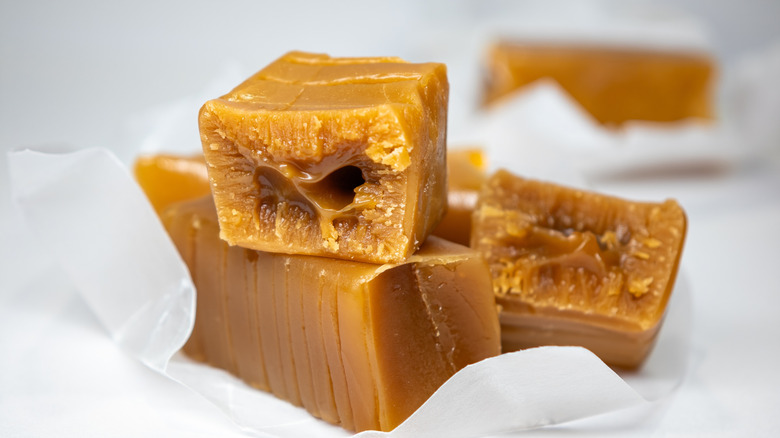The Only Difference Between Butterscotch And Toffee
Butterscotch and toffee often get tossed around interchangeably, especially when it comes to desserts with that golden, buttery sweetness. And, to be honest, it is a bit difficult to tell them apart, since they have similar flavor profiles and shared ingredients. Even so, they're not exactly the same thing. The line between them comes down to how long you cook the sugar — and how hard you let it get. They also shouldn't be confused with caramel. Butterscotch and toffee have distinct characteristics shaped by temperature and texture; one is smooth and sauce-like, the other is crunchy and breakable.
Both start with the same basic ingredients, which are butter and brown sugar. What separates butterscotch from toffee is really just the cooking process; butterscotch is cooked at a lower temperature, resulting in a softer texture that makes it perfect for sauces, fillings, or chewy candies. Toffee is cooked to a much higher heat, which gives you a firm, brittle candy that shatters when bitten. You'll find butterscotch melted over ice cream and toffee chopped into bits and folded into cookies. So each provides a different experience, and understanding the difference makes it easier to decide which one works for your next dessert project.
Butterscotch gives us smoothness and simplicity
Butterscotch has an old-fashioned charm that makes it feel like a throwback to classic candy shops or vintage desserts. Grandmas across the nation carry them in their purses religiously, always ready to hand one out, just because. The candy is made by melting butter and brown sugar together, sometimes with a little bit of cream or vanilla, then heating the mixture to around 225 to 235 degrees Fahrenheit (the soft-ball stage) for a sauce. That lower temperature keeps the sugar from fully hardening, which is why butterscotch stays soft, pourable, and sometimes even gooey, depending on how it's used. Butterscotch candy is cooked at higher temperatures of 270 to 290 degrees Fahrenheit (the soft-crack stage).
The flavor is very deep and caramelized, but it's not bitter. Some recipes call for a pinch of salt or a hint of molasses to round it out. Texture-wise, butterscotch can range from syrupy to chewy, but it's never brittle. That's why you'll see it in sauces, puddings, or chewy wrapped candies rather than crunchy pieces.
If you've ever had butterscotch chips in a cookie, you've tasted a stabilized version of that softer, buttery flavor. The chips differ from butterscotch candy in that they're often made from cane sugar and contain milk solids, vegetable oils, and added flavorings. Still, they're flavor is rich and smooth without being overwhelming, and is very reminiscent of salted caramel in that it's been a dessert workhorse for generations — adding nostalgic and delicious warmth to everything from ice cream sundaes to baking mixes.
Toffee pushes the limit -- and snaps when you bite it
Toffee is basically butterscotch cooked to the max. It starts with the same ingredients of brown sugar and butter, but it's cooked at a higher temperature (about 300 degrees Fahrenheit), known as the hard-crack stage. At that point, the sugar mixture becomes firm, glassy, and brittle once cooled. That's why toffee shatters instead of bends, typically breaking into jagged chunks or clean squares.
The longer cooking time deepens the flavor, sometimes bringing in slightly bitter or nutty notes that balance out the sweetness. Toffee is usually poured out flat, cooled, and broken into pieces, or coated in chocolate and topped with nuts to make the popular English toffee treat. It's less versatile than butterscotch in terms of texture, but what it lacks in softness it makes up for in crunch and intensity.
That glassy texture is also notable in that butterscotch coats your spoon or oozes out into your mouth, but toffee gives you that satiating snap. It's often found in candy bars, brittle, or as chopped-up bits inside baked goods. The two flavors are nearly identical in terms of ingredients, but once toffee hits that higher temperature, it becomes a whole new thing. And that's really the only difference between the two ... how far you take the heat.



